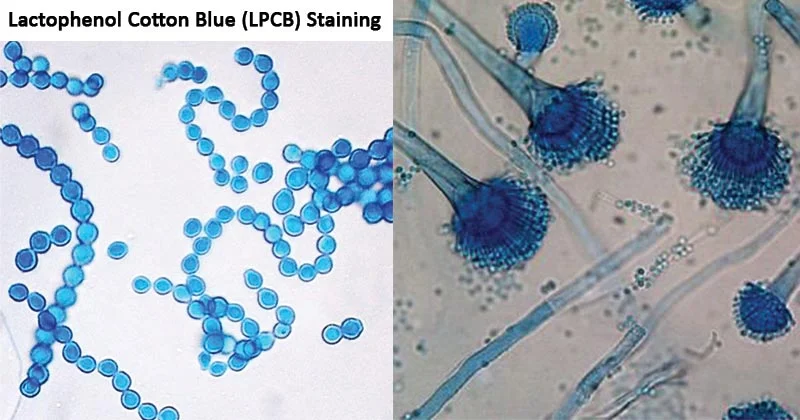Contents:
- Definition of Lactophenol cotton blue Staining:
- Principle of Lactophenol cotton blue Staining:
- Reagents used in Lactophenol cotton blue Staining:
- Preparation of Lactophenol cotton blue Solution:
- Procedure of Lactophenol cotton blue Staining:
- Result of Lactophenol cotton blue Staining:
- Limitations of Lactophenol cotton blue Staining:
- Applications of Lactophenol cotton blue Staining:
Definition of Lactophenol cotton blue Staining:
Lactophenol cotton blue (LPCB) is a staining technique used in microbiology to visualize fungal elements present in direct microscopic examination of clinical specimens, culture plates, or environmental samples. LPCB is a differential stain that determines the presence of fungal elements based on their morphological features. The lactophenol component is a preservative and a clearing examination of clinical specimens. LPCB is a combination of lactophenol solution, which acts as a fixative and clearing agent, and cotton blue stain, which highlights various structures in the fungal cell such as the cell wall, cytoplasm, and nuclei.
Principle of Lactophenol cotton blue Staining:
LPCB staining is based on the principle of differential staining where the fungal elements present in the clinical specimen are selectively stained by the cotton blue stain. The lactophenol solution acts as a fixative and clearing agent that preserves the fungal elements and clears the background for better visualization under the microscope. The cotton blue stain imparts a blue color to the fungal structures, making it easier to differentiate them from other cells or debris present in the background.
Reagents used in Lactophenol cotton blue Staining:
– Lactophenol solution
– Cotton blue stain (cotton blue 2B)
– Distilled water
Preparation of Lactophenol cotton blue Solution:
-
Lactophenol solution:
In a clean glass container, add the following in the given order:
– 10 ml lactic acid
– 10 g phenol crystals
– 10 ml glycerol
– 70 ml distilled water
Mix well and store in a dark bottle.
-
Cotton blue stain:
In a clean glass container, add the following in the given order:
– 1 g cotton blue 2B
– 10 ml lactophenol solution
– 90 ml distilled water
Mix well and filter the solution before use.
Procedure of Lactophenol cotton blue Staining:
- Collect the clinical specimen using a clean swab or other appropriate sampling device.
- Place the swab on a clean microscope slide and add a drop of lactophenol solution to the specimen.
- Spread the specimen and lactophenol solution mixture carefully to form a thin film on the slide.
- Allow the slide to air dry for a few minutes.
- Fix the slide by passing it slowly over a flame or heat source until it is slightly warm to the touch.
- Add a drop of cotton blue stain to the slide and let it stand for 1-2 minutes.
- Rinse the slide gently with distilled water to remove excess stain.
- Air dry the slide and observe under the microscope using the appropriate magnification.
Result of Lactophenol cotton blue Staining:
Under the microscope, the fungal elements present in the clinical specimen will appear blue, while other cells or debris will appear colorless. The various structures in the fungal cell such as the cell wall, cytoplasm, and nuclei will be clearly visible.

Limitations of Lactophenol cotton blue Staining:
- LPCB staining is not effective for all types of fungi, and some fungi may require different stains for proper visualization.
- The staining procedure may not be effective if the specimen is not properly collected or prepared.
- The quality of the stain may be affected by various factors such as the age of the stain, the concentration of the stain, and the pH of the solution.
Applications of Lactophenol cotton blue Staining:
LPCB staining is commonly used in microbiology for the detection and identification of fungal elements present in clinical specimens such as skin scrapings, nail clippings, and respiratory secretions. LPCB staining can also be used for the observation of fungi in environmental samples such as soil, water, and food.
References:
- https://www.fabhow.com/health-and-beauty/personal-care/4-diy-face-serums
- https://quizlet.com/691476526/bacteriology-lab-exam-christine-simmons-biology-250-flash-cards/